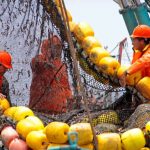As per the information these pharmaceuticals include several delousing agents, such as the two substances diflubenzuron and teflubenzuron. Monitoring data for delousing agents in farmed fish has never revealed residue levels above the internationally established maximum limits. In this way they are safe for seafood. National Institute of Nutrition and Seafood Research, NIFES, has analysed fillet samples from 6200 farmed fish for their content of eight different delousing agents. For the two compounds diflubenzuron and teflubenzuron, which have recently received some attention in Norway, samples of 645 fish have been analysed.
As a result the monitoring data of delousing agents shows that no delousing agent approved for use in fish farming, has been detected above the internationally set maximum residue limits (MRL) in fish for human consumption. Diflubenzuron and teflubenzuron, have never been detected in fish filets. The method used for analyzing these substances are sensitive and enable the detection of diflubenzuron and teflubenzuron at a level of 1% of the MRL.
There were no residues of illegal delousing agents found. Surveillance of delousing agents in fish is part of the annual monitoring programme on undesirable substances in farmed fish, which is initiated by an EU directive on surveillance of foods of animal origin. The number of analyses per year is determined by the production volume and most of the samples are therefore of Atlantic salmon.








